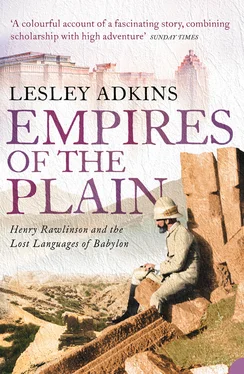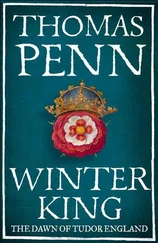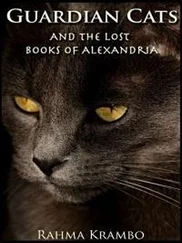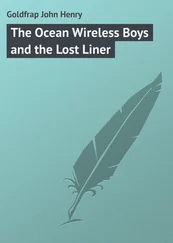In 1771 Abraham-Hyacinthe Anquetil Duperron published the first translation, into French, of the Zend-Avesta. Because Avestan was similar to Old Persian, knowledge of this language was to prove invaluable as it enabled decipherers to work out the vocabulary of Old Persian. Münter at Copenhagen tried to compare the frequency of cuneiform signs in the Old Persian inscriptions with the frequency of letters in Avestan texts, and although his method did not succeed, it led him to suggest correctly that the other two scripts in the trilingual inscriptions from Persepolis were translations of the first.
In July 1802, Rafaello Fiorillo, secretary of the Imperial Library at Göttingen in Germany, was out walking with the twenty-seven-year-old schoolteacher Georg Friedrich Grotefend, a man ‘possessed of an extraordinary memory and excellent health, which allowed him to study from the earliest morning until late at night, without stint or relaxation … although he was considered by persons not in his intimacy, to be of a cold and reserved character, wholly occupied with his recondite studies, and uninterested in anything beyond them, this learned man was really full of feeling, and endowed with an almost child-like simplicity, which endeared him to all those who were of the circle of his friends.’ 5 Fiorillo asked if it could ever be possible to understand cuneiform inscriptions, when both the alphabet and the language were absolutely unknown. Rising to the challenge, Grotefend chose two trilingual inscriptions copied by Niebuhr at Persepolis that looked very similar, examining in each the most simple of the three scripts (the Old Persian). Just a few years earlier, Silvestre de Sacy, an Oriental scholar in Paris, had worked out the meaning of Sasanian (Middle Persian) inscriptions from Naqsh-i Rustam near Persepolis, using the aid of identical inscriptions in ancient Greek. Because they contained the names and titles of kings, Grotefend thought that his cuneiform inscriptions from Persepolis might be similar, but perhaps dating to the time of Xerxes. From these suppositions, he thought that the inscriptions would include the formula ‘Xerxes, great king, king of kings, son of Darius, great king, king of kings, son of Hystaspes’.
Using this method, Grotefend successfully identified the groups of signs for Xerxes, Darius and Hystaspes and also the group of signs for ‘king’, but did not work out all the individual cuneiform signs correctly. Using versions of the names derived from ancient Greek, Hebrew and Avestan, he thought that the cuneiform signs for Darius represented d-a-r-h-e-u-sh (darheush), although in fact they spell da-a-ra-ya-va-u-sha (darayavaush). The cuneiform signs for Xerxes  were identified by him as kh-sh-h-e-r-sh-e (khshhershe), but they are actually xa-sha-ya-a-ra-sha-a (xashayarasha).
were identified by him as kh-sh-h-e-r-sh-e (khshhershe), but they are actually xa-sha-ya-a-ra-sha-a (xashayarasha).
The group of signs  that Grotefend believed meant ‘king’ gave him kh-sh-e-h-?-?-h, when looking at identical signs within darheush and khshhershe. From the Avesta, he knew that khsheio was a royal title, so he deduced that the missing signs were i and o, to give khshehioh, although the word is actually xa-sha-a-ya-tha-i-ya (xashayathaiya). By working out the values of the signs
that Grotefend believed meant ‘king’ gave him kh-sh-e-h-?-?-h, when looking at identical signs within darheush and khshhershe. From the Avesta, he knew that khsheio was a royal title, so he deduced that the missing signs were i and o, to give khshehioh, although the word is actually xa-sha-a-ya-tha-i-ya (xashayathaiya). By working out the values of the signs  that he thought represented the name Hystaspes, and by filling in the gaps, Grotefend arrived at g-o-sh-t-a-s-p (goshtasp), although it is now spelled vi-i-sha-ta-a-sa-pa (vishatasapa).
that he thought represented the name Hystaspes, and by filling in the gaps, Grotefend arrived at g-o-sh-t-a-s-p (goshtasp), although it is now spelled vi-i-sha-ta-a-sa-pa (vishatasapa).
From identifying these names, Grotefend next worked out part of the alphabet for Old Persian, not realizing that many signs represented syllables, not single alphabetical letters. Despite many errors, he had achieved the first steps in decipherment, and his remarkable results were announced to the Academy of Sciences at Göttingen in four papers from September 1802 to May 1803 and published in 1805 within a book by Arnold H. L. Heeren – Ideen über die Politik, den Verkehr und den Handel, der vornehmsten Völker der alten Welt (Ideas on the politics, communication and trade of the first peoples of the ancient world).
Grotefend’s results were applauded in Paris by de Sacy, whose own pupil Saint-Martin tried to improve on the alphabet, but with minimal success. Just before his death in 1832, Saint-Martin was studying copies of the trilingual Elwand inscriptions, which were subsequently handed to Burnouf, who was working on Avestan and Sanskrit, two closely related ancient languages. Burnouf’s Commentaire sur le Yaçna was published from 1833 to 1835 – the Yasna was part of the Zend-Avesta, and this commentary far outstripped Duperron’s earlier translation of the Zend-Avesta. It was while Burnouf was preparing the Elwand inscriptions for publication that Rawlinson was carefully copying the very same inscriptions on his way from Tehran to Kermanshah in April 1835.
Towards the end of April, Rawlinson reached Kermanshah, where he would become well acquainted with the town and its people. Situated at an altitude of over 4,000 feet, on the edge of an extensive plain and at the foothills of a range of the Zagros mountains, Kermanshah controlled trade between the surrounding region and Baghdad to the south-west in Turkish territory. A fortified mud-brick wall, roughly circular in plan and with five gates, surrounded the town’s flat-roofed mud-brick houses, extensive covered bazaars, palace, baths, caravanserais and mosques, although imposing domes and minarets were noticeably lacking, in spite of Shi’ite Muslims being in the majority. Equally obvious was the sparse population, which had more than halved to around 12,000 after a recent plague epidemic. Five years later, in 1840, the adventurer Austen Henry Layard (a future collaborator with Rawlinson on cuneiform) travelled to Kermanshah and gave his initial impressions: ‘It stands in a fine, well-watered plain, surrounded by lofty serrated mountains towering one above the other, with high precipitous peaks, then still covered with snow. It is a place of considerable size, in the midst of gardens, vineyards, and orchards, amongst which are wide-spreading walnut trees and lofty poplars. An abundant supply of water descended from the mountains, divided into numerous canals, irrigated the lands, and rendered them bright with verdure. Altogether I was very favourably impressed with the appearance of the place from a distance. I thought it one of the prettiest and most flourishing towns I had seen in the East.’ 6
Finding himself in this mountainous region with many tantalizing inscriptions, Rawlinson was instantly lured to nearby Taq-i Bustan, with its Sasanian rock-cut reliefs and grottoes, several centuries later in date than those trilingual cuneiform inscriptions at the foot of Mount Elwand that he had recently copied. The Taq-i Bustan reliefs included one of King Khusro II, who was a contemporary of the Prophet Muhammed and ruled from AD 594 to 628. The king, seated on his favourite horse Shabdiz, is in full armour and helmet, holding a lance and looking very much like the knights of medieval Europe. Throughout Persia, sculptured reliefs of Fath Ali Shah and his court had been carved next to Sasanian reliefs, including one here at Taq-i Bustan, so continuing a long tradition.
What really gripped Rawlinson’s attention, though, was hearing about another trilingual cuneiform inscription, located at Bisitun, 20 miles from Kermanshah. Frustratingly, no sooner had he discovered the inscription than his work as a soldier demanded his total commitment. Within weeks of arriving he had gained Bahram Mirza’s trust to such an extent that it was laid down that Persian soldiers of all ranks would take orders from him, while he himself would only take orders from the prince. ‘The Prince’, he recorded, ‘took to me, was very kind and gave me the practical command of the Province’ 7 – including arms, equipment, stores, and the recruitment and training of the troops.
Читать дальше

 were identified by him as kh-sh-h-e-r-sh-e (khshhershe), but they are actually xa-sha-ya-a-ra-sha-a (xashayarasha).
were identified by him as kh-sh-h-e-r-sh-e (khshhershe), but they are actually xa-sha-ya-a-ra-sha-a (xashayarasha). that Grotefend believed meant ‘king’ gave him kh-sh-e-h-?-?-h, when looking at identical signs within darheush and khshhershe. From the Avesta, he knew that khsheio was a royal title, so he deduced that the missing signs were i and o, to give khshehioh, although the word is actually xa-sha-a-ya-tha-i-ya (xashayathaiya). By working out the values of the signs
that Grotefend believed meant ‘king’ gave him kh-sh-e-h-?-?-h, when looking at identical signs within darheush and khshhershe. From the Avesta, he knew that khsheio was a royal title, so he deduced that the missing signs were i and o, to give khshehioh, although the word is actually xa-sha-a-ya-tha-i-ya (xashayathaiya). By working out the values of the signs  that he thought represented the name Hystaspes, and by filling in the gaps, Grotefend arrived at g-o-sh-t-a-s-p (goshtasp), although it is now spelled vi-i-sha-ta-a-sa-pa (vishatasapa).
that he thought represented the name Hystaspes, and by filling in the gaps, Grotefend arrived at g-o-sh-t-a-s-p (goshtasp), although it is now spelled vi-i-sha-ta-a-sa-pa (vishatasapa).










